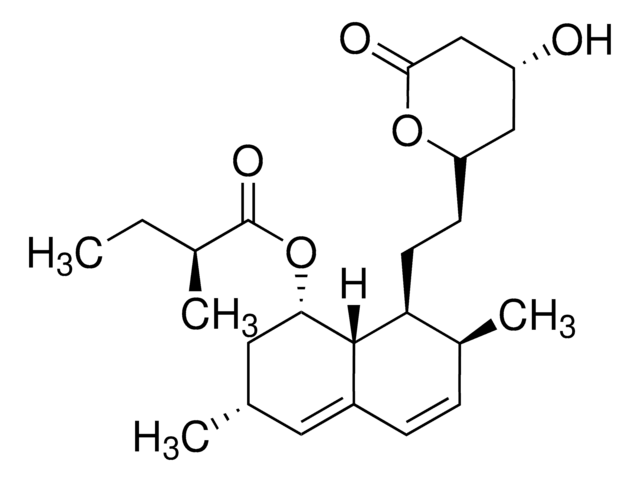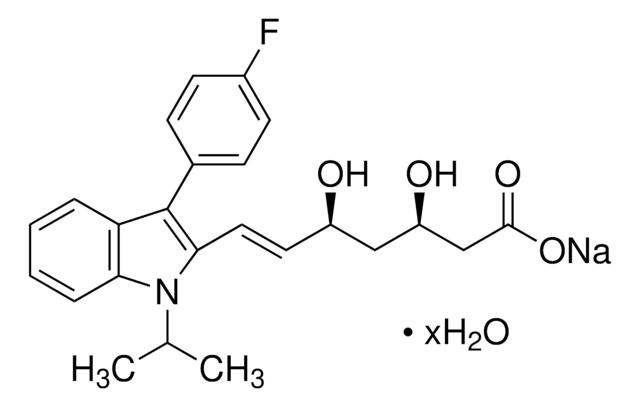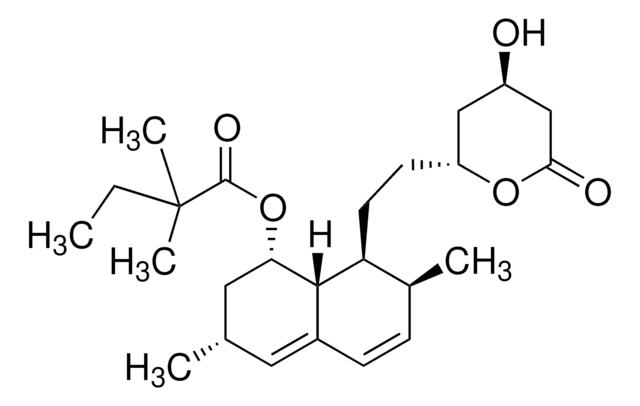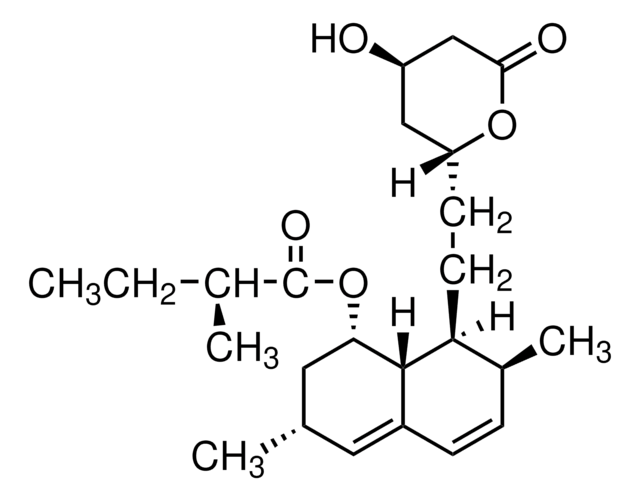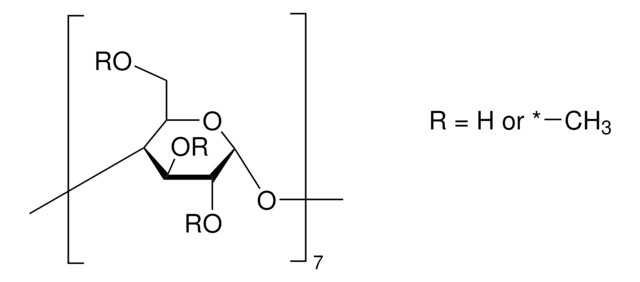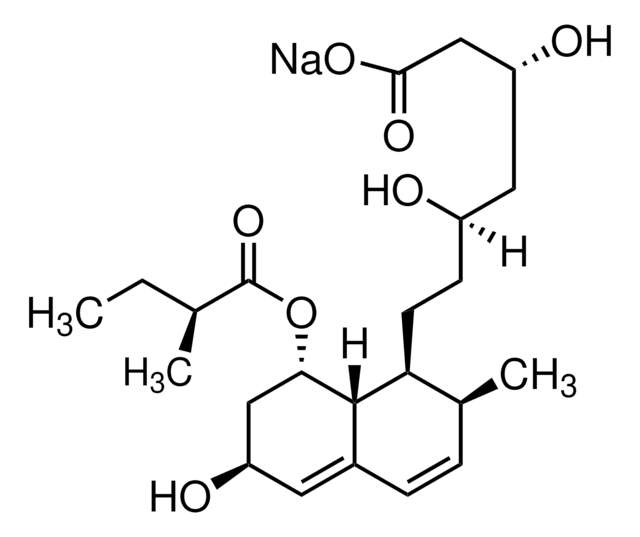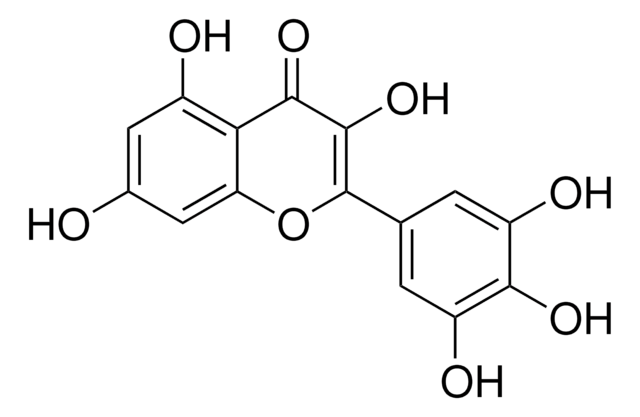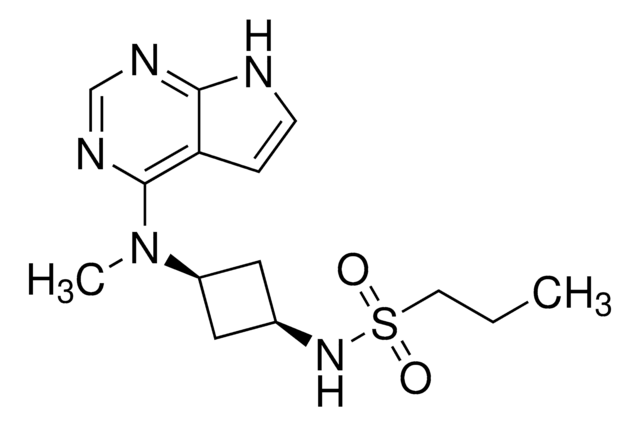438187
Lovastatin, Sodium Salt
InSolution ≥95%
Sinônimo(s):
InSolution Lovastatin, Sodium Salt
Faça loginpara ver os preços organizacionais e de contrato
About This Item
Fórmula empírica (Notação de Hill):
C24H37O6 · Na
Peso molecular:
444.54
Código UNSPSC:
51111800
NACRES:
NA.77
Produtos recomendados
Nível de qualidade
Ensaio
≥95% (HPLC)
Formulário
liquid
fabricante/nome comercial
Calbiochem®
condição de armazenamento
OK to freeze
avoid repeated freeze/thaw cycles
protect from light
Condições de expedição
dry ice
temperatura de armazenamento
−70°C
Descrição geral
Carboxylate form of Lovastatin (Cat. No. 438185) that is active in whole cells and cell-free assays. Lovastatin is reported to be an anti-hypercholesterolemic agent that acts as a reversible competitive inhibitor of 3-hydroxy-3-methylglutaryl coenzyme A (HMG-CoA) reductase and blocks a series of biological events including activation of p21ras by insulin in 3T3-L1 fibroblasts and 3T3-L1 adipocytes, farnesylation of p21ras, which decreases the pool of intracellular Ras available for subsequent activation by growth factors (including insulin), and N-ras-induced neuronal differentiation. Causes cell cycle arrest in the late G1 phase. Shown to inhibit the stimulation of MAP kinase by insulin in HIRcB cells and block the transcription of the type-I SCR gene in THP-1-derived macrophages. Also blocks PDGF receptor tyrosine phosphorylation and MAP kinase activation by PDGF.
Ações bioquímicas/fisiológicas
Cell permeable: yes
Primary Target
HMG-CoA reductase
HMG-CoA reductase
Reversible: yes
Embalagem
Packaged under inert gas
Advertência
Toxicity: Harmful (C)
forma física
A 10 mM (5 mg/1.13 ml) solution of Lovastatin, Sodium Salt (Cat. No. 438186) in H₂O.
Reconstituição
Following initial thaw, aliquot and freeze (-70°C). Aliquots are stable for up to 6 months at -70°C.
Outras notas
Rao, S., et al. 1999. Proc. Natl. Acad. Sci. USA96, 7197.
Carel, K., et al. 1996. J. Biol. Chem.271, 30625.
McGuire, T.F., et al. 1996. J. Biol. Chem.271, 27402.
Umetani, N., et al. 1996. Biochim. Biophys. Acta1303, 199.
Xu, X.Q., et al. 1996. Arch. Biochem. Biophys.326, 233.
Reusch, J.E.-B., et al. 1995. J. Biol. Chem.270, 2036.
Carel, K., et al. 1996. J. Biol. Chem.271, 30625.
McGuire, T.F., et al. 1996. J. Biol. Chem.271, 27402.
Umetani, N., et al. 1996. Biochim. Biophys. Acta1303, 199.
Xu, X.Q., et al. 1996. Arch. Biochem. Biophys.326, 233.
Reusch, J.E.-B., et al. 1995. J. Biol. Chem.270, 2036.
Informações legais
CALBIOCHEM is a registered trademark of Merck KGaA, Darmstadt, Germany
Código de classe de armazenamento
12 - Non Combustible Liquids
Classe de risco de água (WGK)
nwg
Ponto de fulgor (°F)
Not applicable
Ponto de fulgor (°C)
Not applicable
Certificados de análise (COA)
Busque Certificados de análise (COA) digitando o Número do Lote do produto. Os números de lote e remessa podem ser encontrados no rótulo de um produto após a palavra “Lot” ou “Batch”.
Já possui este produto?
Encontre a documentação dos produtos que você adquiriu recentemente na biblioteca de documentos.
Patrícia M R Pereira et al.
Clinical cancer research : an official journal of the American Association for Cancer Research, 26(23), 6215-6229 (2020-10-02)
Statins are cholesterol-depleting drugs used to treat patients with hypercholesterolemia. Preclinically, statins disrupt trafficking of receptors present at the cell membrane. Membrane receptors, defined as tumor biomarkers and therapeutic targets, are often internalized by an endocytic pathway. Indeed, receptor endocytosis
Nossa equipe de cientistas tem experiência em todas as áreas de pesquisa, incluindo Life Sciences, ciência de materiais, síntese química, cromatografia, química analítica e muitas outras.
Entre em contato com a assistência técnica